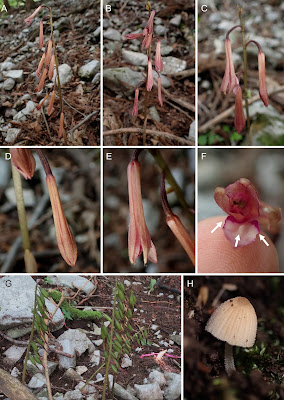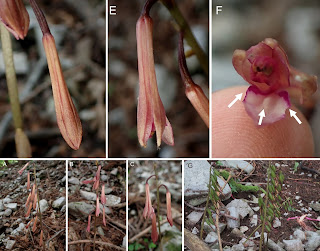 |
| Cremastra saprophytica Suetsugu, in Suetsugu, 2021. |
Abstract
A new species of Cremastra (Orchidaceae), C. saprophytica, is described from Gifu Prefecture, Japan. The new species is similar to C. aphylla in having a leafless and mycoheterotrophic habit. However, it is distinguishable from C. aphylla by its green stem, more closed perianth tube, smaller lateral lobes of lip, smaller callus of lip positioned at base of the midlobe and absence of a rostellum and viscidium. An illustration and ecological information on the new species are provided. A key to the Cremastra species is also provided.
Keywords: Calypsoinae, Japanese flora, mycorrhiza, mycoheterotrophy, new species, self-pollination, taxonomy
Cremastra saprophytica Suetsugu, sp. nov.
Type:—JAPAN. Gifu Pref.: Ibi County, Ibigawa Town, Kasugakawai, 5 Jun 2021, Suetsugu Sa52 (holotype: KYO!, spirit collection).
Cremastra saprophytica is similar to C. aphylla but differs by its more closed perianth tube, smaller lateral lip lobes, smaller callus positioned at base of the midlobe and lack of rostellum and viscidium.
Distribution and phenology:—Cremastra saprophytica is only known from the type locality. Flowering occurred from late May to early June, and fruiting from late June to early October.
Kenji Suetsugu. 2021. Cremastra saprophytica (Orchidaceae: Epidendroideae), A New Leafless Autonomously Self-pollinating Orchid Species from Gifu Prefecture, Japan. Phytotaxa. 527(2); 89-96. DOI: 10.11646/phytotaxa.527.2.1





